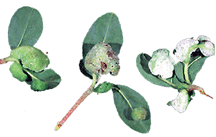 The Bay Gardener by Dr. Frank Gouin
The Bay Gardener by Dr. Frank Gouin
Azaleas Invaded by Aliens
Those strange growths are leaf galls; get rid of them
Since mid-May, I have received a number of calls from Bay Weekly readers concerning azalea leaf galls. Azalea leaf galls appears as fleshy gray to gray-pink growth on last year’s leaves. Sometimes only a portion of the leaves are consumed by the fleshy fungal growth, while at other times the entire leaf may be covered. The fungus causes the leaves to produce abnormal growths, which will contain the fruiting bodies of the disease. Once these fruiting bodies rupture, the spores are spread rapidly by air currents. If you have this problem on your azaleas, it is important that you take corrective action now, and again early next spring.
The best control is to handpick and destroy each gall. Before you destroy, however, you may want to taste a few because I have known nurserymen who’ve enjoyed them as snacks, although I’ve never tried them myself. On the same subject, I have recently discovered that the Japanese have a liking for corn smut.
Whatever you do, don’t discard the galls on the ground or in the compost pile because that will encourage the spread of this disease next spring. If you are not going to snack on them, either burn them or place them in the garbage.
Next spring, just before the new growth appears and as soon as the first flowers wilt, spray the plants thoroughly with a Bordeaux mixture, Bravo, Zineb or any fungicide containing a metal such as copper or zinc. Repeat the spray treatment as soon as the fungal growths reappear.
Azalea leaf gall is more of a problem on certain species than others. Many of the greenhouse forcing varieties of azaleas are more susceptible to azalea leaf gall than some of our standard hardy varieties such as Delaware Valley white, Hershey red and tradition.
Nasturtiums Thrive Under Nasty Treatment
Q I was off to an enthusiastic start on nasturtiums in April, starting seeds inside in a strawberry jar, regular potting soil, full sun. But they haven’t started flowering. They’ve been out on the deck for seven to 10 weeks. What’s wrong?
–Ann Wolfe, Deale
A If you are feeding your nasturtiums a lot of fertilizers, they will only produce foliage. Nasturtiums need to be starved a little before they start flowering. Also, they flower best in full sun. Stop feeding them and let them wilt a little before you irrigate them.